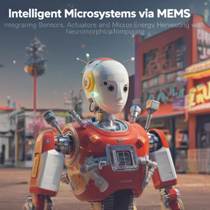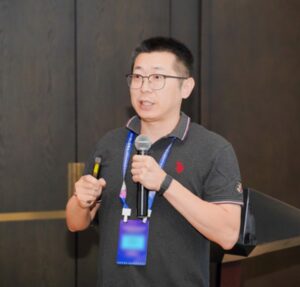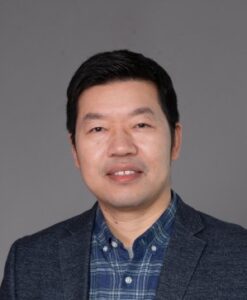JMM特刊征稿|基于MEMS的智能微系统:传感器、神经形态芯片和微能量

特刊详情
客座编辑

冀健龙 教授
太原理工大学
- 冀健龙,太原理工大学教授,博士生导师。太原理工大学集成电路学院副院长,人工智能微纳传感山西省重点实验室副主任,获三晋英才、山西省青年拔尖人才。现任中国微米纳米学会青年工作委员会委员,中国仪器仪表学会微纳器件与系统技术分会理事,在Advanced Science、Infomat等期刊发表论文60余篇,授权发明专利20余项。研究工作获山西省自然科学一等奖,山西省自然科学二等奖各一项。

王婷 教授
南京邮电大学
- 王婷教授以第一/通讯作者在Nature Electronics、Nature Communications、Advanced Materials(5篇)等国际知名学术期刊共发表SCI论文20余篇,SCI总他引4000余次,H指数33(Web of science);主持国家优青、国家自然科学基金(面上、青年)、江苏特聘教授等项目。参与编著《集成微纳系统的前沿技术》电子皮肤智能感知章节和《生物电子学》。获评为Mine青年科学家(2023)、Nanoscale新锐科学家(2022),作为客座编辑受邀在Biosensors期刊上组织Flexible biosensors特刊(2022),黑科技挑战杯省赛一等奖指导教师(排名第一)。受邀参加16th Pacific polymer conference、香山会议、iCANX等会议并做邀请报告。

刘威 教授
武汉大学
- 刘威,武汉大学集成电路学院教授、国家自然科学基金“优青”人才、工信部集成电路领军人才、湖北省半导体协会副会长、湖北省物理学会副秘书长、武汉物理学会秘书长、武汉大学-华为集成电路“未来技术精英班”项目主任、武汉大学半导体校友会副会长。刘威教授长期从事MEMS、微流控芯片、传感器芯片的研究工作,作为通讯作者或第一作者在Advanced Materials, ACS nano, Advanced Functional Materials等国际期刊发表SCI收录论文100余篇。所发表文章的总他引次数超过7000次,多篇论文获评为高被引论文,H-index影响因子超过35。先后主持国家自然科学优青项目,科技部重点专项,国家自然科学基金重大仪器专项,国家自然科学基金面上项目多项。两次获得湖北省自然科学一等奖。

何剑 教授
中北大学
- 何剑,中北大学教授、博导,电子科技大学博士,美国布朗大学访问学者;现为教育部青年长江学者、国务院政府特殊津贴专家、中共山西省委联系服务专家、国家国防科技创新团队方向带头人、中国青年五四奖章集体骨干成员。主要从事微纳传感器、智能感知、无人平台等技术领域的研究,先后承担国家自然科学基金重点项目、国防基础科研重点项目、装备发展部预研、国家重点研发计划课题、国家重大型号装备等科研项目20余项。已发表SCI论文100余篇,累计他引3000余次;授权国家发明专利16余项,获山西省自然科学一等奖2项、获山西省技术发明一等奖1项;现为中国指控学会智能可穿戴技术分委会委员、中国指控学会青年工作委员会委员、中国微米纳米学会微系统与微执行器分会理事。
主题范围
This special collection explores intelligent microsystems enabled by Micro-Electro-Mechanical Systems (MEMS) technology. It highlights the synergy among neuromorphic chips (brain-inspired hardware), microsensors, and micro-energy harvesting devices—the core components defining next-generation intelligent microsystems—focusing on how their integration fosters adaptive, efficient solutions. The issue aims to showcase cutting-edge advances in this rapidly evolving field, where merging sensing, neuromorphic computing, and energy autonomy through innovative designs unlocks breakthroughs for real-world applications.
With rising demand for smart healthcare, robotics, and the Internet of Things (IoT), intelligent microsystems are pivotal for next-generation technology. This collection addresses urgent needs for miniaturized, energy-efficient solutions that process information via brain-inspired neural network architectures. We highlight this field now due to recent leaps in MEMS fabrication, neuromorphic hardware innovation, and energy-scavenging material development—making the integration of sensors, neuromorphic chips, and micro-energy units more viable than ever.
Topics include:
- Energy-efficient computing architectures tailored for MEMS-integrated neuromorphic systems
- MEMS-based Neuromorphic chips for sensor coordination and intelligent data processing
- Self-powered microsystems using environmental energy harvesting
- MEMS-based smart sensors (e.g., biomedical monitoring, environmental sensing, industrial detection)
- Intelligent integration methods for autonomous operation of sensor-neuromorphic-micro-energy microsystems
Please note that all submissions to this collection must also be in scope of the journal.
投稿流程
特刊文章与JMM期刊常规文章遵循相同的审稿流程和内容标准,并采用同样的投稿模式。
有关准备文章及投稿的详细信息,可以参阅IOPscience页面的作者指南。
作者可登入期刊主页进行在线投稿,先选择“文章类型”,然后在“选择特刊”的下拉框中选择“Focus Collection on Intelligent Microsystems via MEMS: Sensors, Neuromorphic Chips and Micro-Energy”。
投稿截止日期:2026年3月30日。
期刊介绍

- 2024年影响因子:2.1 Citescore:5.0
- Journal of Micromechanics and Microengineering(JMM)是该领域的领军期刊,涵盖了微型机电结构、设备和系统,以及微观力学与微机电的各个方面。JMM专注于制造和集成技术方面的原创性研究,推广新的制造技术及设备。该期刊的研究范围包括微型工程和纳米工程学,涉及物理、化学、电子和生物等领域,也发表关于硅和非硅材料的制造和集成方面的最新研究。
